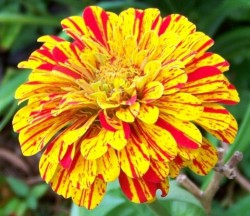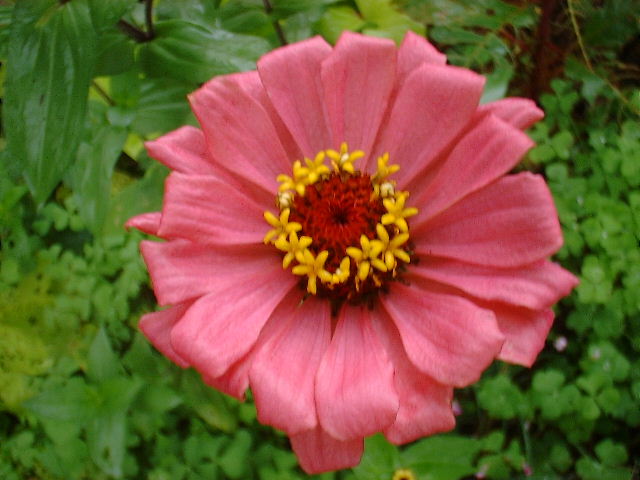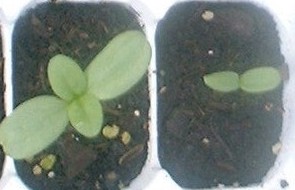 If
you didn't grow any Zinnias this year, put them on the top of the spring
wish list for next year, and you will thank yourself over and over all season.
This is a plant that is started incredibly easily from seed, flowers very
quickly, has a wide range of flower types and colors, withstands full sun
and heat, makes an excellent cut flower, attracts bees and butterflies,
and can make the difference between so-so garden bed and a spectacular garden
showcase. Whether a beginner or a seasoned gardener, there is a Zinnia
out there for every taste, budget, and style. Creating a Zinnia garden
is the perfect way to teach children about gardening, and they will delight
in the big, bright, bold colors.
If
you didn't grow any Zinnias this year, put them on the top of the spring
wish list for next year, and you will thank yourself over and over all season.
This is a plant that is started incredibly easily from seed, flowers very
quickly, has a wide range of flower types and colors, withstands full sun
and heat, makes an excellent cut flower, attracts bees and butterflies,
and can make the difference between so-so garden bed and a spectacular garden
showcase. Whether a beginner or a seasoned gardener, there is a Zinnia
out there for every taste, budget, and style. Creating a Zinnia garden
is the perfect way to teach children about gardening, and they will delight
in the big, bright, bold colors.
 Zinnias
are another member of the large Aster family of plants and originate in
Mexico and the Southwest United States. They come in a form suitable
for every garden situation, including single, double, cactus, dahlia, ruffles,
and pompon. Colors include every shade except blue, and many
are multicolored. Most are prolific bloomers that add beautiful color
to the landscape, and many have growth habits that make wonderful additions
to container plantings. The uses for Zinnias in the home garden are
almost endless. Use them as border plants, fillers for bare spots
in perennial gardens, or massed in a garden all their own.
Zinnias
are another member of the large Aster family of plants and originate in
Mexico and the Southwest United States. They come in a form suitable
for every garden situation, including single, double, cactus, dahlia, ruffles,
and pompon. Colors include every shade except blue, and many
are multicolored. Most are prolific bloomers that add beautiful color
to the landscape, and many have growth habits that make wonderful additions
to container plantings. The uses for Zinnias in the home garden are
almost endless. Use them as border plants, fillers for bare spots
in perennial gardens, or massed in a garden all their own.
 Zinnias
are ridiculously easy to start from seed, grow quickly, and adapt well to
many gardening situations. Seed can be started indoors and seedlings
can be transplanted easily outside for earlier bloom, or the seeds can be
started in the garden after the last frost date when the soil has warmed.
Germination is not as good in cold soil. Bedding plants are also available,
but since the seeds are so easy to grow, the need for buying bedding plants
is questionable. The photo at the bottom of the page shows seeds at
about 1.5 weeks and 4 days. Average soil is good enough for Zinnias,
and they will tolerate a little neglect here and there as far as watering
and weeding, as long as you don't go to extremes.
Zinnias
are ridiculously easy to start from seed, grow quickly, and adapt well to
many gardening situations. Seed can be started indoors and seedlings
can be transplanted easily outside for earlier bloom, or the seeds can be
started in the garden after the last frost date when the soil has warmed.
Germination is not as good in cold soil. Bedding plants are also available,
but since the seeds are so easy to grow, the need for buying bedding plants
is questionable. The photo at the bottom of the page shows seeds at
about 1.5 weeks and 4 days. Average soil is good enough for Zinnias,
and they will tolerate a little neglect here and there as far as watering
and weeding, as long as you don't go to extremes.
 Zinnias
do need regular deadheading for best performance. Never doing this
chore will seriously reduce both the number of blooms and the life span
of the plant itself. Although most individual Zinnia plants bloom
for many weeks, eventually they do go into a rather rapid decline, turning
into an unsightly brown dead-looking plant. Therefore, the best policy
is to start new plants every few weeks during the growing season to replace
the spent plants. Once the plant starts to decline, there's no turning
back, so just pull it and replace with a new one. I know it's hard
to let go when there is one sickly little bloom left on there, but you have
to be strong! I personally keep a flat of seedlings going at all times.
As I transplant a seedling to the garden, I refill the potting soil and
plant a new seed in its place. This insures that I always have plants
waiting to go when I need them.
Zinnias
do need regular deadheading for best performance. Never doing this
chore will seriously reduce both the number of blooms and the life span
of the plant itself. Although most individual Zinnia plants bloom
for many weeks, eventually they do go into a rather rapid decline, turning
into an unsightly brown dead-looking plant. Therefore, the best policy
is to start new plants every few weeks during the growing season to replace
the spent plants. Once the plant starts to decline, there's no turning
back, so just pull it and replace with a new one. I know it's hard
to let go when there is one sickly little bloom left on there, but you have
to be strong! I personally keep a flat of seedlings going at all times.
As I transplant a seedling to the garden, I refill the potting soil and
plant a new seed in its place. This insures that I always have plants
waiting to go when I need them.
 In
a
Habitat type situation, Zinnias are veritable
beneficial insect magnets. As noted above, they will thrive in less-than-perfect
soil conditions as long as their minimum sun requirement is met (at least
6 hours a day).
In
a
Habitat type situation, Zinnias are veritable
beneficial insect magnets. As noted above, they will thrive in less-than-perfect
soil conditions as long as their minimum sun requirement is met (at least
6 hours a day).
Problems with Zinnias are few, but
there can be issues with fungus, bacteria, and mildew. Mealybugs,
spider mites, and caterpillars can also cause damage. Plant
spacing to allow for air circulation, and bottom watering will circumvent
mildew problems, and a strong stream of water with or without insecticidal
soap should keep mealybugs and spider mites within reasonable limits.
The best pest control, however, is to use other plants that attract beneficial
insects that will feed on the pests, such as in
companion planting.
A well-rounded, healthy garden rarely has serious insect infestations.
Zinnias are not a poisonous plant
and are safe for gardens frequented by children and pets. However,
they are not a culinary flower, and are not used as food garnishes, etc.,
though cut flowers do make a colorful and elegant centerpiece for the table.

 If
you didn't grow any Zinnias this year, put them on the top of the spring
wish list for next year, and you will thank yourself over and over all season.
This is a plant that is started incredibly easily from seed, flowers very
quickly, has a wide range of flower types and colors, withstands full sun
and heat, makes an excellent cut flower, attracts bees and butterflies,
and can make the difference between so-so garden bed and a spectacular garden
showcase. Whether a beginner or a seasoned gardener, there is a Zinnia
out there for every taste, budget, and style. Creating a Zinnia garden
is the perfect way to teach children about gardening, and they will delight
in the big, bright, bold colors.
If
you didn't grow any Zinnias this year, put them on the top of the spring
wish list for next year, and you will thank yourself over and over all season.
This is a plant that is started incredibly easily from seed, flowers very
quickly, has a wide range of flower types and colors, withstands full sun
and heat, makes an excellent cut flower, attracts bees and butterflies,
and can make the difference between so-so garden bed and a spectacular garden
showcase. Whether a beginner or a seasoned gardener, there is a Zinnia
out there for every taste, budget, and style. Creating a Zinnia garden
is the perfect way to teach children about gardening, and they will delight
in the big, bright, bold colors.  Zinnias
are another member of the large Aster family of plants and originate in
Mexico and the Southwest United States. They come in a form suitable
for every garden situation, including single, double, cactus, dahlia, ruffles,
and pompon. Colors include every shade except blue, and many
are multicolored. Most are prolific bloomers that add beautiful color
to the landscape, and many have growth habits that make wonderful additions
to container plantings. The uses for Zinnias in the home garden are
almost endless. Use them as border plants, fillers for bare spots
in perennial gardens, or massed in a garden all their own.
Zinnias
are another member of the large Aster family of plants and originate in
Mexico and the Southwest United States. They come in a form suitable
for every garden situation, including single, double, cactus, dahlia, ruffles,
and pompon. Colors include every shade except blue, and many
are multicolored. Most are prolific bloomers that add beautiful color
to the landscape, and many have growth habits that make wonderful additions
to container plantings. The uses for Zinnias in the home garden are
almost endless. Use them as border plants, fillers for bare spots
in perennial gardens, or massed in a garden all their own.
 Zinnias
do need regular deadheading for best performance. Never doing this
chore will seriously reduce both the number of blooms and the life span
of the plant itself. Although most individual Zinnia plants bloom
for many weeks, eventually they do go into a rather rapid decline, turning
into an unsightly brown dead-looking plant. Therefore, the best policy
is to start new plants every few weeks during the growing season to replace
the spent plants. Once the plant starts to decline, there's no turning
back, so just pull it and replace with a new one. I know it's hard
to let go when there is one sickly little bloom left on there, but you have
to be strong! I personally keep a flat of seedlings going at all times.
As I transplant a seedling to the garden, I refill the potting soil and
plant a new seed in its place. This insures that I always have plants
waiting to go when I need them.
Zinnias
do need regular deadheading for best performance. Never doing this
chore will seriously reduce both the number of blooms and the life span
of the plant itself. Although most individual Zinnia plants bloom
for many weeks, eventually they do go into a rather rapid decline, turning
into an unsightly brown dead-looking plant. Therefore, the best policy
is to start new plants every few weeks during the growing season to replace
the spent plants. Once the plant starts to decline, there's no turning
back, so just pull it and replace with a new one. I know it's hard
to let go when there is one sickly little bloom left on there, but you have
to be strong! I personally keep a flat of seedlings going at all times.
As I transplant a seedling to the garden, I refill the potting soil and
plant a new seed in its place. This insures that I always have plants
waiting to go when I need them.  In
a
In
a 